The Case For Upskilling
How the Pandemic has Exposed Skill Gaps in the Workplace
The events of the last two years have reshaped and accelerated existing trends, created new demands, and given rise to companies, leaders, and employees to reevaluate many aspects of work. New rules, expectations, and ways of working have formed a playbook for the long term. However, these shifts have highlighted critical gaps in skills for both employees and leaders to deliver in this new environment.
Download the PDF (English & French Included)
Introduction
The past two years were a living case study of how the old way of working is broken. Hierarchical decision-making, the slow pace of change, and an aversion to trying different business strategies and operating models were gone seemingly overnight. Internal silos eroded, functional leaders were empowered to make decisions, and characteristics like speed, agility, innovation, and resilience rose to prominence.
There is no going back to the way things were for many employees. The pandemic fundamentally changed their expectations of the leaders and companies they work for - forever. Now, organizations and leaders are under pressure to meet those changes by rethinking how they set policies, conduct business, and lead their teams. Those who don’t and remain stuck in old ways of working will feel the very real effects of the great resignation sooner or later.
In this guide, we’ll review the state of work today, why upskilling is critical to remain competitive, and the future skills needed for success today and tomorrow.
The Current State of Work: What We’ve Learned
The pandemic has reshaped and accelerated existing trends, created new demands, and given rise to companies, leaders, and employees reevaluating many aspects of work. Here are four ways the past two years have amplified the conversation of upskilling and future skills at many boardroom tables.
Redefining Work
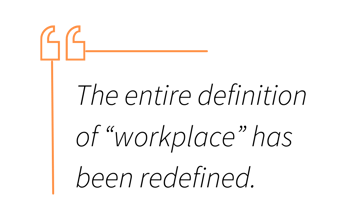 Pre-2020 conversations about remote work were often shot down; the rationale being that working remotely would hinder productivity, collaboration, and company culture. In fact, it seemed to be a luxury reserved for those in tech and marketing companies.
Pre-2020 conversations about remote work were often shot down; the rationale being that working remotely would hinder productivity, collaboration, and company culture. In fact, it seemed to be a luxury reserved for those in tech and marketing companies.
However, that all changed in 2020 as remote work became the norm across nearly all industries and roles out of sheer necessity. Organizations that couldn’t fathom a few individuals working remotely from time-to-time, suddenly had every employee working remotely full-time. What’s been proven is that it matters less where work is completed, and more how the work gets done.
In a survey conducted by FlexJobs in August 2021, they found employees have widely embraced the idea of permanent remote work.
What kind of work arrangement would you prefer post-pandemic?
- 58% fully remote
- 39% hybrid
- 3% fully in-person
Are you willing to make sacrifices or changes to maintain a remote work setup?
- 29% are currently searching for a new job that allows them to work remotely
- 21% would be willing to forgo some vacation time for a remote working option
- 24% are willing to take a 10 - 20% pay cut to work remotely as much as they want
Why do you want to work remotely?
- 50% said reduced commute stress
- 47% said more time with family
- 43% said reduced exposure to illness such as colds and flu
The idea of working remotely post-pandemic is appealing for many employees. The time and cost savings and reduced stress from not having to commute, feeling trusted by their bosses, and additional time with family have made remote and hybrid work arrangements something many employees want to continue.
Not to mention, companies have learned that remote work is not only possible, but profitable. Employees remain engaged and productive with new levels of trust from the leader and organization, and in some cases, the savings from not having a physical location positively benefits the bottom line. Remote work has also opened up the talent pool as companies are no longer confined to a single geographical area.
For a while, remote work was seen as temporary, but now, it is more than evident that remote and hybrid work is here to stay to some degree. As such, organizations need to put plans into place to upskill employees and leaders with the training they need to contribute to a remote/hybrid work environment effectively..png?width=1920&name=Working%20Remotely%20Post-Pandemic%20(1).png)
A Reset of Priorities
A light has gone on for many. The past two years have profoundly impacted individuals, leaders, and companies. The effect has ignited reprioritizations and realizations about work. Ann Stansbury, Inequality and Social Policy Scholar at Harvard University, highlights the one realization many employees have had:
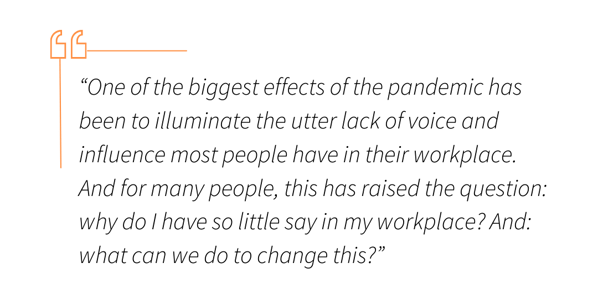 Employees are questioning the meaning behind their work, the type of company they want to work for, and their overall experience. In turn, the companies rising to the challenge have realized that things need to change. Kristine Derv, a research scientist at MIT Center for Information Systems Research, notes, “Companies are leaving a lot of value on the cutting room floor by not investing in the experience of their employees.”
Employees are questioning the meaning behind their work, the type of company they want to work for, and their overall experience. In turn, the companies rising to the challenge have realized that things need to change. Kristine Derv, a research scientist at MIT Center for Information Systems Research, notes, “Companies are leaving a lot of value on the cutting room floor by not investing in the experience of their employees.”
There is a desire for a more human workplace, one that is full of purpose, connection, social awareness, empathy, and inclusion. Employees today want and are willing to actively seek out a safe, emotionally healthy work environment. In other words, people don’t want work to be something they do to survive; rather, they want it to be a place where they can truly thrive.
Cisco, who took the number one spot in 2021 on the World’s Best Workplaces list, has taken an intentional approach to building a culture where employees want to work. Disparti Sen, a Software Engineer for Cisco, explains, “Cisco has always been a place which upholds the principle of #LoveWhereYouWork because the company cares deeply for its employees and the world at large.”
Retaining and attracting the very best talent is paramount during the great resignation. Employees are actively looking for organizations where the mission, vision, and values align with their own. A company where the purpose in their work is greater than creating shareholder value. They want a culture of trust, transparency, safety, and personal development and growth, where companies step up and address the human aspects of work such as burnout, mental health, and work-life balance. They seek this in their employee experience and leave if it cannot be fulfilled.
The Pace of Change
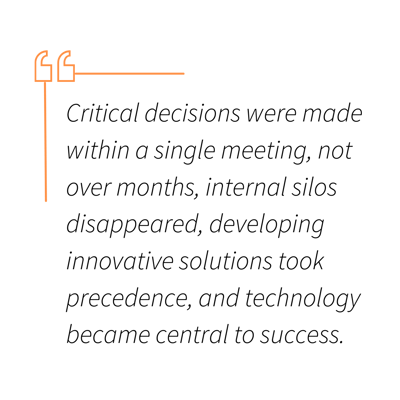 Before the pandemic, when we asked supervisors, managers, and senior leaders if navigating VUCA (volatility, uncertainty, complexity, and ambiguity) made their jobs difficult, most individuals agreed. Today, when we pose this question, it’s a resounding and loud “YES!” from every individual. The unpredictable, dramatic, and fast nature of change needed to keep pace was something leaders, and individuals alike were unprepared for.
Before the pandemic, when we asked supervisors, managers, and senior leaders if navigating VUCA (volatility, uncertainty, complexity, and ambiguity) made their jobs difficult, most individuals agreed. Today, when we pose this question, it’s a resounding and loud “YES!” from every individual. The unpredictable, dramatic, and fast nature of change needed to keep pace was something leaders, and individuals alike were unprepared for.
Pre-pandemic, change initiatives would start with consultants and focus groups, buy-in and support were gathered, significant time was spent on due diligence before making a decision, and the initiative would be slowly rolled out to the organization. However, when the pandemic began, companies had to change quickly to service customers, navigate supply chain challenges, shift to virtual work, and encourage virtual collaboration between colleagues and direct reports.
As Satya Nadella, Microsoft’s CEO, said, “We’ve seen two years’ worth of digital transformation in two months.” The pandemic has highlighted how inefficient the old model for decision-making and change was. The need for speed is here to stay. Organizations need to embrace agility, empower teams and functional leaders to make decisions, and encourage innovation to remain competitive going forward.
Unprepared for What Was Ahead
The pandemic has forced everyone across an organization to shift the way they work to adapt to rapidly changing conditions. During the past two years, leaders and individuals found themselves in a new work environment where they were barely hanging in; ill-equipped to tackle the unprecedented challenges thrown their way.
This has taken a toll on employees and those leading them, as 69% of U.S. employees surveyed report that the pandemic was the most stressful time of their entire career. But it didn't have to be this way. An investment in developing the skills of resilience, creativity, learning agility, adaptability, and building relationships before the pandemic would have eased the fallout many experienced. However, the next best time to develop the skills is today.
.png?width=1920&name=Employee%20Working%20from%20Home%20Office%20(1).png)
The Case for Upskilling
From the experiences, challenges, and opportunities of the last two years, new rules and ways of working have formed a playbook for the long term. As a result, talent strategies need to be updated in order to pritiorize the upskilling of employees and leaders.
For employees, the experiences from the last two years have highlighted critical gaps in skills needed to deliver in this new environment. These once nice-to-have skills have become imperative to generating sustainable growth and long-term value, from agility and change leadership to resilience and collaboration in a remote setting.
Upskilling managers, supervisors, department heads, and senior leaders to lead in a distributed, employee-centered environment is also critical. As Drew Houston, co-founder and CEO of Dropbox, noted, “[The future of work] requires a new social contract and shift in mindset for employers and employees. Companies will need to rely on managers to find the right policies and behaviors for their teams. They’ll also have to trust employees to get their work done without constantly monitoring face time, and people will have to take more accountability for their results.”
Here’s a look at where we were to where we’re going and the new requirements of leaders to engage and retain employees as organizations shift towards an employee-centric workplace of the future.
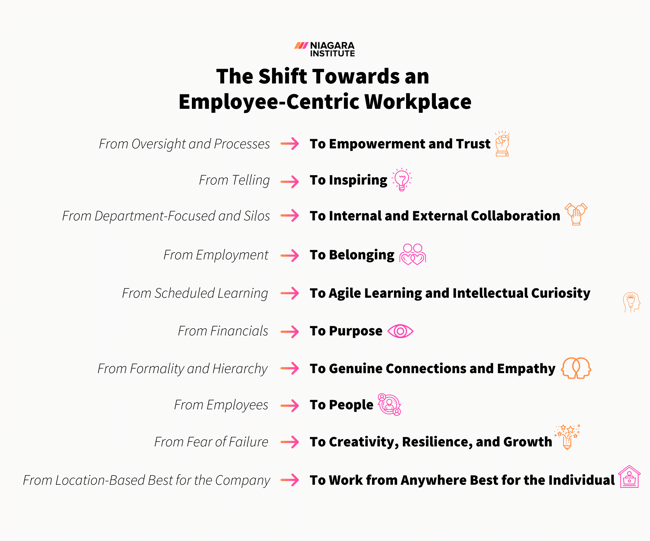
Closing the Skill Gap
In the new normal, soft skills are the hard skills of the future. They have become table stakes for organizations to build these competencies in their workforce. It’s these transferable, human-centric skills that allow individuals to transcend job shifts, build relationships, facilitate trust, and adapt to new ways of working.
In fact, many CEOs agree that these human-centric skills are critical to success in this new era of work. To be specific, 75% of CEOs in a 2021 survey by Ernst and Young (EY) responded that empathy and soft skills are the most important capabilities in the next five years.
Fortunately, a recent global survey by McKinsey uncovered that closing the skill gap is a priority for many organizations, with 69% of respondents agreeing their companies are engaging in more upskilling than they did before the pandemic.
With so many new skills needing to be developed, it can be overwhelming to know where to start with an upskilling strategy. That’s why we’ve compiled a list of 7 skills that should be on the top of every professional development list.
Growth Mindset and Learning Agility
Over 30 years ago, Carol Dweck, a professor at Stanford University, was interested in students' attitudes about failure. In studying the behavior of thousands of children, she coined the phrase “growth mindset” which is a belief that one's talents, skills, and abilities can be developed and honed through hard work, as opposed to a fixed mindset, where one holds the belief that intelligence is a deep-seated trait, thus cannot be developed.
When individuals adopt a growth mindset and learning agility, a willingness to learn and apply new competencies, the focus shifts to working hard to understand, learning from mistakes, and wanting to take on challenges. When organizations foster a growth mindset and learning agility, they can experience higher employee engagement, resilience, innovation, and overall performance.
In an article for HBR, Carol Dweck explains, “When entire companies embrace a growth mindset, their employees report feeling far more empowered and committed; they also receive far greater organizational support for collaboration and innovation. In contrast, people at primarily fixed-mindset companies report more of only one thing: cheating and deception among employees, presumably to gain an advantage in the talent race.”
Imagine what could happen if every individual across an organization possessed a growth mindset and learning agility? If they were always ready for change? If everyone truly believed they could learn and find solutions to almost any problem?
Lara Albert of SAP articulated the need for these skills perfectly. She shared in her Forbes article, “How can organizations upskill and reskill their workforce at the speed required to keep up with this change? Better yet, how can employees still thrive when the concept of work and the workplace are ever-evolving? The key to future readiness is putting human needs at the center of employee experience – and for that, learning agility should be a top priority for global business leaders.”
.png?width=1920&name=Employee%20with%20a%20Growth%20Mindset%20at%20Work%20(1).png)
Curiosity
Albert Einstein once famously claimed, “I have no special talents. I am only passionately curious.” Going hand in hand with a growth mindset and learning agility is curiosity. Curiosity, also called intellectual curiosity, is the desire to acquire new knowledge and dig deeper than the surface on a topic. It’s when you want to learn more without having to be told or coaxed to do so.
Given the pace of change and the need to constantly learn new things to adapt, curiosity is ranked as one of the most essential competencies across all sectors, functions, roles, and geographies. In SAS's 2021 survey of US managers, 57% of respondents strongly agreed that curiosity in their employees drives results, while 54% strongly agreed that employees who demonstrate curiosity were typically higher performers than their peers who did not show this skill.
In addition, according to the HBR article, The Business Case for Curiosity, “Curiosity improves engagement and collaboration. Curious people make better choices, improve their company's performance, and help their company adapt to uncertain market conditions and external pressures.” However, despite the benefits of curiosity, the same article noted that just 24% reported feeling curious in their jobs regularly and 70% said they faced barriers to asking more questions.”
The case is clear for individuals to develop curiosity and for organizations to create an environment that fosters inquiry, both of which can be accomplished with training for individuals and their leaders.
Resilience
Ask anyone what the one skill they wished they had developed prior to the pandemic, and most would agree it is resilience. Having resilience is the ability to adaptively overcome stress and adversity. Put another way; it’s one’s ability to bounce back when faced with adversity.
It’s too late to build resilience to meet the challenges many faced at the start of the pandemic; however, now is the time for building resiliency to be prepared for the next time we face adversity. Developing habits that promote resilience before we need it helps us cope better and be more resilient when the time comes.
Anne Grady, author of Mind Over Moment: How to Harness the Power of Resilience, agrees the time to build resilience is before you need it. She says, “Resilience is a collection of skills and habits, and it is a practice. Resilience isn’t one of those things you either have or don’t. It’s a continued practice of cultivating habits that strengthen your resilience muscle.”
Every individual has a different level of resilience; that’s why what one person can brush off may impact another person much more. Luckily, despite the level of resilience one has, everyone can build their level of resilience with knowledge and practice.
Virtual Collaboration
With so much technology available at our fingertips, allowing us to collaborate in real-time or asynchronously, why does it still take so much time to make decisions? A recent McKinsey article posed the same question and concluded that, “In our efforts to connect across our organizations, we’re drowning in real-time virtual interaction technology, from Zoom to Slack to Teams, plus group texting and everything in between. There’s seemingly no excuse not to collaborate. The problem? Interacting is easier than ever, but true, productive, value-creating collaboration is not. And what’s more, where engagement is occurring, its quality is deteriorating. This wastes valuable resources because every minute spent on a low-value interaction eats into time that could be used for important, creative, and powerful activities.”
Virtual collaboration goes beyond knowing how to schedule a meeting in Zoom or post a meme in Slack. Remote work requires more than tools for remote collaboration; it requires a new set of skills to be successful. Ones where leaders are equipped to create and lead teams in a virtual environment, and where individuals are productive and truly collaborating on the things that matter, not superficial interactions disguised as virtual collaboration.
According to Gallup, with 91% of employees hoping to be working at least some of their hours remotely after the pandemic, remote employees, teams, and those who are leading them are here to stay, and so, developing the skills to work together virtually are critical.

Creativity
Creativity and innovation are much sought-after skills in today’s workplace. So much so, 94% of hiring managers say it’s important to evaluate an applicant's creativity when evaluating a job candidate, while LinkedIn boldly claimed it is the most important skill in the world.
Encouraging and fostering creativity at work is beneficial to both individuals and the company in which they work. Creativity benefits individuals as when we’re engaged in creative work that we enjoy, it reduces anxiety and stress and improves cognitive function. For organizations, creativity enables individuals to discover and further develop ideas and combine diverse elements of information to form original ideas, innovations, and solutions to problems.
To develop creativity in individuals, they need to understand why creativity is essential, how it takes on different forms, and the common roadblocks to creativity, as well as have the chance to practice being creative in environments that have little to no risk. Fortunately, the right training program will check all of these boxes.
Connectivity
More than ever, quality connections with individuals are crucial to business success. The pandemic and the subsequent shift to remote work, have many feeling less than connected to their peers and leaders. In fact, a study by Pew Research Center found that 65% of employees who work from home feel less connected to their coworkers. This is concerning given that a lack of connection and belonging is tied to increased turnover, reduced productivity and job performance, and increased absenteeism.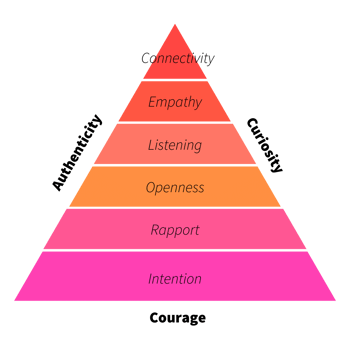
As a result, organizations are focused on shifting employees and leaders from intention (“I’m willing to know you”) to empathy and connectivity (“I’m with you”). Granted, this is easier said than done, as true connections and relationships require a level of authenticity, vulnerability, and courage many are not used to in the workplace.
Fortunately, a training program delivered to employees and leaders can help develop a mutual understanding and motivation to create a culture focused on trust, relationships, empathy, and connectivity.
Storytelling
Connections cannot happen without communication, and storytelling is a key communication skill for fostering connections. Whether it is between the messenger and the audience or the audience and an idea, telling stories is a way to connect and engage with the listener emotionally. It’s an opportunity to authentically share experiences that make the messenger more relatable to the audience and inspire trust, confidence, and action.
In addition to building connections, storytelling aids in understanding and information retention. For example, it has been found we’re 22 times more likely to remember a fact that is wrapped in a story than we are a speech full of facts and figures.
With the knowledge of how to craft compelling stories and the practice in doing so, any individual or leader can learn the skill of storytelling. When seeking out training, find a highly practical and hands-on solution that allows just as much time for learning as practicing and feedback.
.png?width=1920&name=Storytelling%20in%20the%20Workplace%20(1).png)
Next Steps
Many have waited with bated breath to go back to work as we once knew it, but after two years of significant change, it’s safe to say that just isn’t possible. As a BBC research study of 4,700 knowledge workers found, the majority of people never want to go back to the old way of working. In fact, they would rather quit as part of the great resignation than compromise on their newfound values, expectations, and priorities.
So, what’s next then? As this guide has hopefully made clear, the next step for organizations and leaders alike is to adapt and prepare for the next wave of change that will inevitably come.
To do this, upskilling will be absolutely necessary. As a McKinsey report noted, 69% of organizations have already doubled down on upskilling efforts since the pandemic began. Of those who have done so on a large scale, “between 71 and 90% say it has had a positive impact on their ability to realize company strategy, employees’ performance and satisfaction, and their reputation as an employer.”
Fortunately, when you’re ready to start upskilling yourself or your team, there are a number of options available to you. From an open-enrollment program where participants learn new skills along with others from a variety of organizations to a program for participants delivered for the same organization, the options are endless. Not to mention, with a training provider like Niagara Institute and Eagle’s Flight, you’ll have the added benefit of being able to customize a solution to your organization’s unique need through means of content design or modification, assessments, or coaching.
This Guide Was Created in Collaboration With Eagle's Flight

Founded in 1971, The Niagara Institute is dedicated to providing highly relevant learning experiences to the everyday leader. With a network of content partners and topics spanning from leadership, communication, diversity and inclusion, and business acumen, the Institute is able to provide high potentials, people managers, seasoned leaders, and human resources teams the content they need when they need it, anywhere in the world. In addition to training programs, the Niagara Institute offers coaching services, assessments, advisory services, and custom training programs.

Founded in 1988, Eagle’s Flight is a global leader in the development and delivery of business-relevant, experiential learning programs that result in the release of human potential and lasting behavioral change. Eagle’s Flight corporate training engages and challenges participants at all levels; delivering a competitive edge to organizations through improved workforce performance and increased productivity. Eagle’s Flight has clients in a wide range of industries including Automotive, Agriculture, Food & Beverage, Finance, Pharmaceutical, Mining and Energy sectors.
Get Your PDF
Save This For Later
After filling out the form, we will send you to the PDF version and also a copy to your email so you can file it away or share it with your colleagues.

